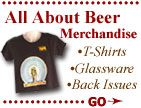
| ||||
| AAB Departments |
| ...Beer Features |
| ...Beer Talk |
| ...Pull Up A Stool! |
| ...What's Brewing |
| ...Beer Travelers |
| ...Stylistically Speaking |
| ...Beer & Food |
| ...Homebrewing |
| ...Collectibles |
| ...Marketplace |
| Beer Lovers' Resources |
| ...World Beer Festival |
| ...Brew Cruise Info |
| ...AAB Merchandise |
| ...AAB Bookstore |
| ...Beer Links |
| About the Magazine |
| ...Subscription Info |
| ...Retail the Magazine |
| ...Wholesaler Program |
| ...Advertising Info |
| ...Contact AAB |

|
All About Beer Magazine
Volume 24 Number 1
March 2003
 Beer Trays
Beer Trays
by Dave Gausepohl
Probably when consumers decided that lager or ale was their cup of tea, the need for a serving tray was born. Early examples of beer serving trays–made of brass, copper and nickel-plated steel–resembled the platters of the prized tea sets our ancestors used to cherish. As both a beverage service tool and a form of advertising, the beer tray was an instant success. The fact that this innovation served such a simple purpose, as well as sped up service, most probably helped to increase its popularity.
Trays were mostly produced in three shapes–round, rectangular and oval. These shapes were finished with a rounded, a flared or a straight-sided ringed rim. Some early trays were baked with a porcelain coating similar to your mother’s cookware or the inside of an oven.
Many short-lived breweries may not have produced a great deal of advertising and in some cases the only known items to exist are these breweries’ trays. The trays produced before Prohibition really show us the artistic talents this country. Their lithographs of bottles and glassware make you feel that you could almost reach out and taste the beer of long ago.
In many cases, the trays were placed on display in the taverns and restaurants where they were utilized. The lithographed artwork truly pushed the envelope. Today, some of the beer serving trays most sought after as collectables are those with factory scenes, Victorian women, or brewery mascots.
This advertising medium was also used in a smaller format for the bartender’s gratuity. Tip trays, as they were known, were just the right size for some change or bills "To Improve Promptness." Often, the tip trays were just a smaller replica of their service counterparts in shape and design.
Some interesting trays have a series of numbers on their face relating to the number and position of patrons seated at a table. This innovation would help speed up service and avoid mistakes on the server’s part.
In later years, trays have been made from aluminum, plastic and, in some cases, glass. That some establishments served beer only in bottles led some breweries to produce a carrier that would cradle the bottles to the table. This specialized tray not only sped up service but also cut down on spillage.
Some manufacturers of beer coasters produced a tray liner made from a pulp-like material to fit the diameter of the tray. These liners created a non-slip surface and could also be used to cover the advertising of a competing brand.
In the late 1960s, the metal tray was pushed aside by the advent of a molded plastic tray. These cheaper and less appealing trays thankfully did not last. A number of melamine trays also were produced around this same time. Happily for collectors, some companies still produce the metal versions of beer trays and some microbreweries have even issued trays in the last few years.
----------------------------
Beer Dave Gausepohl has collected breweriana since 1974 and has a personal collection of over 400,000 items. He has visited over 1,000 breweries and tasted well over 10,000 different brews from the world over.








